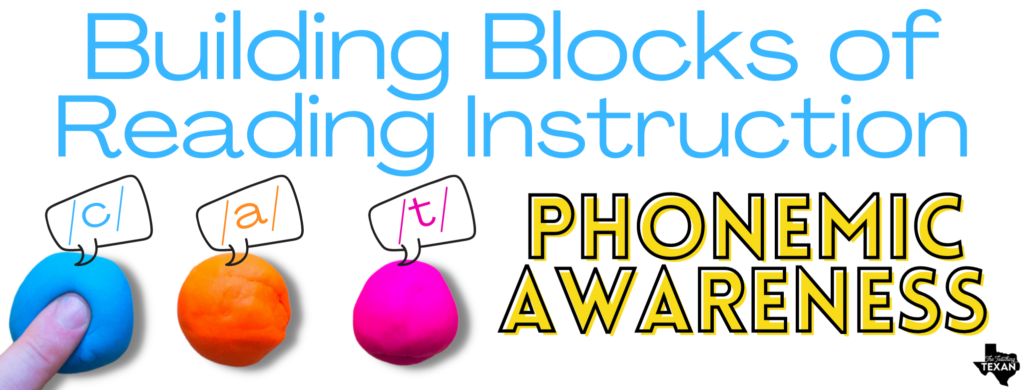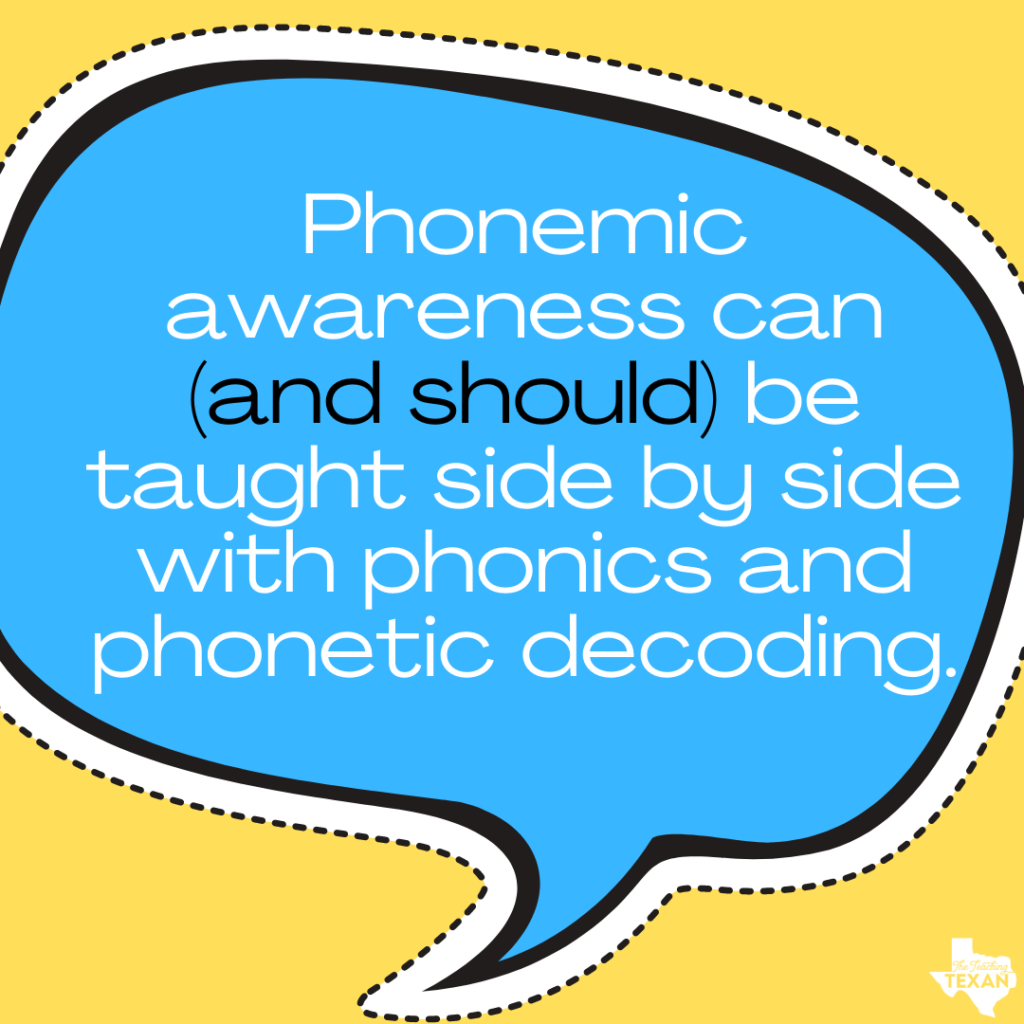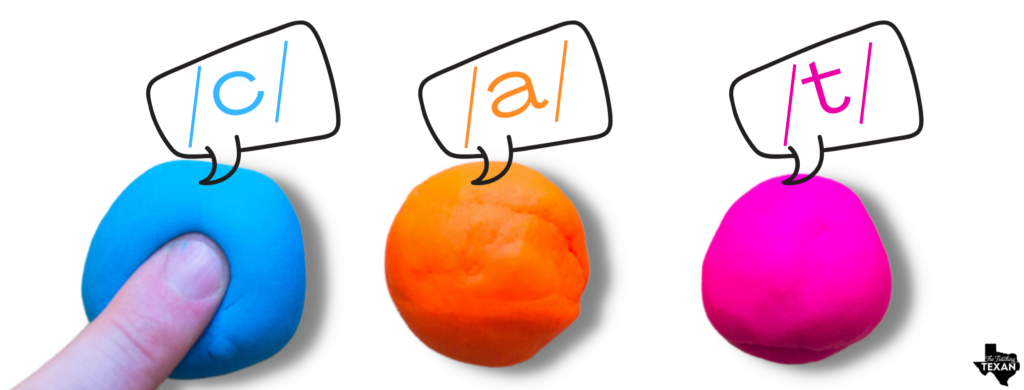Building Blocks of Reading: Phonemic Awareness
Welcome back to the Building Blocks of Reading y’all! We began in January with rhyming and alliteration, then moved onto letter knowledge. We built upon that foundation with intermediate phonological awareness (complex challenges like sentence segmenting, syllables, onset and rime), and last week tackled phonics and phonetic decoding.

By now you may have noticed we’ve been bouncing back and forth between the oral and written/visual skills necessary for children to read successfully at grade level. This is because, both oral and written/visual abilities can be practiced simultaneously when working with children who are first learning to read. Strengthening both skills at the same time gives them a strong base to work from.
Of course, certain skills build on top of others — students will find it difficult to successfully understand phonics if they don’t have the proper letter knowledge first! — but the phonemic awareness we’re discussing today can (and should) be taught side by side with the phonics and phonetic decoding discussed last week.

Um, could you remind me about Phonemes real quick?
Don’t worry, I got you. Phonemes “are the smallest unit of spoken language that we can perceive, so if we are to fully understand language we need to understand what a phoneme is (and learn to hear it!) because we need to understand all the other parts of spoken language. More importantly, phonemes help us understand the relationship among words, letters and sounds” (Liben and Liben 2019).
In other words, they’re the sounds that make up the words. The tricky part can be that the amount of phonemes doesn’t always correspond to the amount of letters. A word with four letters doesn’t always have four phonemes. A word with five letters may have only two phonemes (ex: weigh — /w/ /ā/). And so on.
Phonemic awareness is the most complex skill that falls on the phonological awareness continuum we discussed in our rhyming and alliteration post.
In the classroom, students learn to identify sounds in words in the order of (1) beginning, (2) ending, and (3) medial. We should keep this in mind when working on these skills. Students understand the middle sounds LAST. So they should be introduced so students practice in that same order – beginning, ending, and middle.
Try it TODAY
Here are a few quick and easy ways to add phoneme instruction to your literacy block. These can be done as a whole group or added as centers!
Counting sounds
This activity helps students find phonemes in individual words and it can lead to really interesting discussions with students! While this is primarily an oral activity, you may wish to incorporate manipulatives for learners to have something to do with their hands. Try counting sounds with modeling dough – the kids LOVE it and adds that tactile feel that some kids need!

When you begin, start out with words that have 2 or 3 easy phonemes. Then, show the written word after students have discovered the phonemes. This helps them grasp the concept that phonemes aren’t the same as letters when they see that words often have fewer phonemes (sounds) than letters. (Woohoo phonics instruction tie in!) For example, tea has 3 letters but only 2 phonemes /t/ /ē/; grow has 4 letters but only 3 phonemes /g/ /r/ /ō/ etc.
Manipulating phonemes in words
Now here’s where the fun part starts. Once students understand phonemes, they can start to play with them! There are tons of fun ways to add this to your centers or group activities so definitely give yourself and students some creative freedom here.
But basically the three skills you’ll want students to master are…
Adding Sounds
Give students a word orally, for example, “mat” and ask them to add a sound to the beginning or end. (Example: adding /s/ to the end makes the words “mats”.) You can have individual students hold phonemes on a piece of paper or white board and rearrange themselves to make new words, making this a whole body game. It can get silly so factor in time for giggles!
Deleting Sounds
Again, start by giving students a word orally, for example, “rat”. But this time, ask them to delete a sound. (Example: deleting /r/ makes the word “at”.) A white board and magnetic letters can be helpful here as well so students can visually remove sounds and see what’s left. BUT, make sure to keep the distinction between sounds and letters, reminding students they don’t always correspond one-to-one. This is still an auditory skill, but a quick visual can sometimes be helpful.

Substituting Sounds
This activity is particularly fun with students on their feet. Plus, it’s an easy way to practice whatever word families you’re working on at the moment. Start by giving students a word orally, for example, “hit” and ask them to change a sound. (Example: /h/ to a /s/ sound becomes “sit”.) This can also be done with manipulatives. Magnetic letters work really well!

Word to the wise…. When working with the “it” word family, be prepared for a student to inadvertently want to add the sh phoneme in front! Try to contain yourself — you’re a professional 😝😝
Next week we’ll be moving on to orthographic mapping to take our kiddos from successful early readers to full fluency. See you then friends! In the meantime, post your favorite phoneme activities below!
References:
Know Better, Do Better, Liben and Liben, Learning Sciences International, 2019.

I was asked by an adult recently what a ‘ over a letter means, then what two dots over letters mean. My oldest daughters middle name is Die’dre, the first e had a long A sound.
Then I read your post and it reminded me how so much of accomplishing a degree, the job you want, life and what you want from it, is directly proportional to ones ability to read. This is my opinion only. I am probably not expressing exactly what I’m trying to say, simply because words have so many different meanings to each person.
To me, ones ability to read will directly influence where one goes and what one does in life.
As a first grade teacher, I often forget about the importance of teaching rhyming skills as it used to be something kids learned outside of the classroom or in previous years. Now more than ever I can see how crucial it is to their learning and phonemic awareness.